Understanding Bipolar Disorder: Symptoms, and Treatment Options
VerifiedAdded on 2022/12/21
|6
|1316
|75
Essay
AI Summary
This essay provides an overview of bipolar disorder, a chronic mental health condition characterized by extreme mood swings. It explores various aspects of the disorder, including its symptoms such as anxiety, panic attacks, depression, mania, and hypomania. The essay emphasizes the impact of bipolar disorder on young people, highlighting the importance of early diagnosis and treatment. It discusses different treatment approaches, including medication and psychotherapy, and stresses the need for societal awareness and support for individuals affected by the condition. The essay also references key studies and research findings related to bipolar disorder, offering a comprehensive understanding of the illness. It concludes by advocating for increased vigilance and support for individuals affected by bipolar disorder, emphasizing the treatable nature of the condition and the importance of government initiatives to identify and assist those in need. The essay highlights the necessity of educating families on how to recognize the disorder and the importance of providing appropriate care and support to improve the quality of life for those affected.
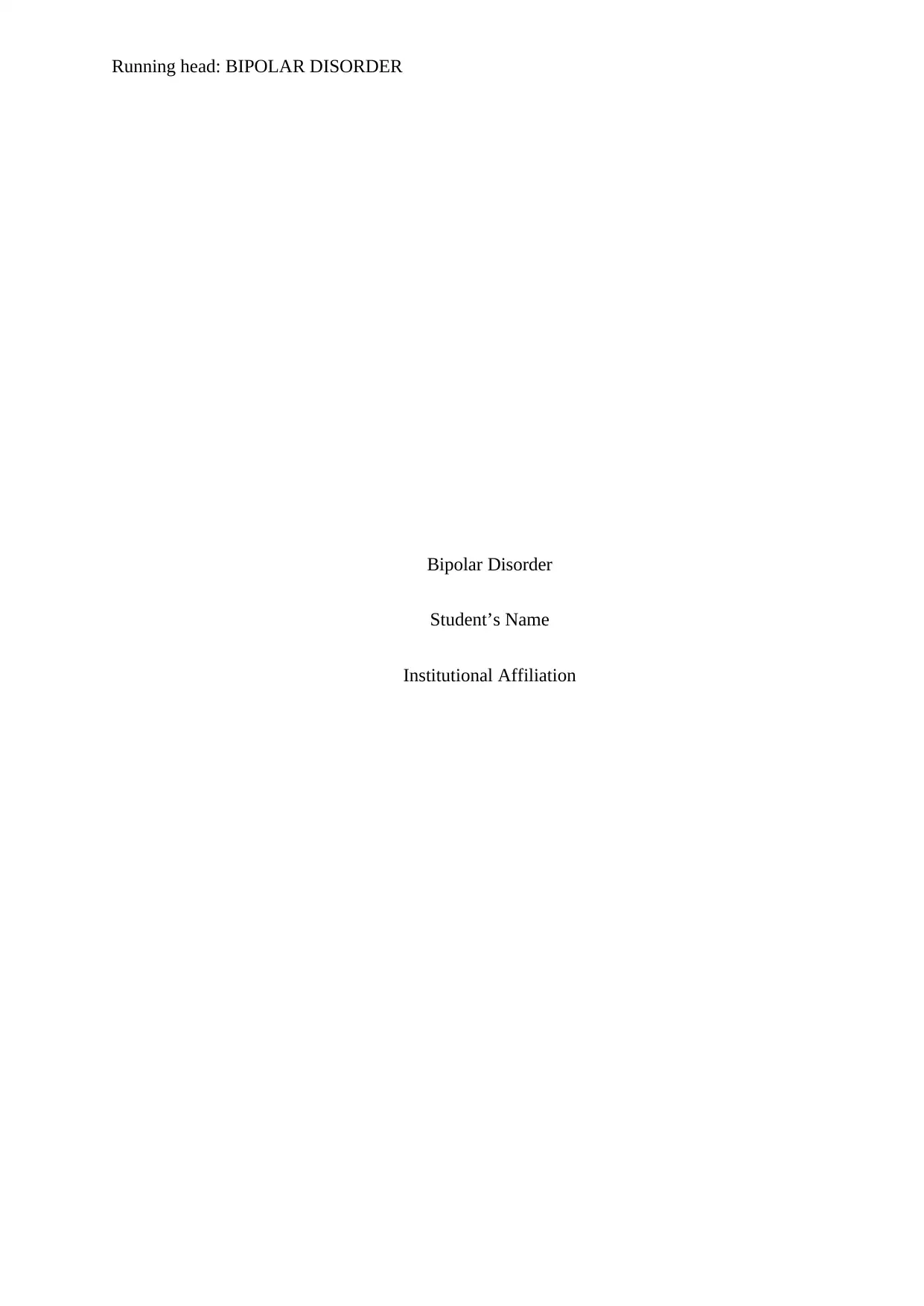
Running head: BIPOLAR DISORDER
Bipolar Disorder
Student’s Name
Institutional Affiliation
Bipolar Disorder
Student’s Name
Institutional Affiliation
Paraphrase This Document
Need a fresh take? Get an instant paraphrase of this document with our AI Paraphraser
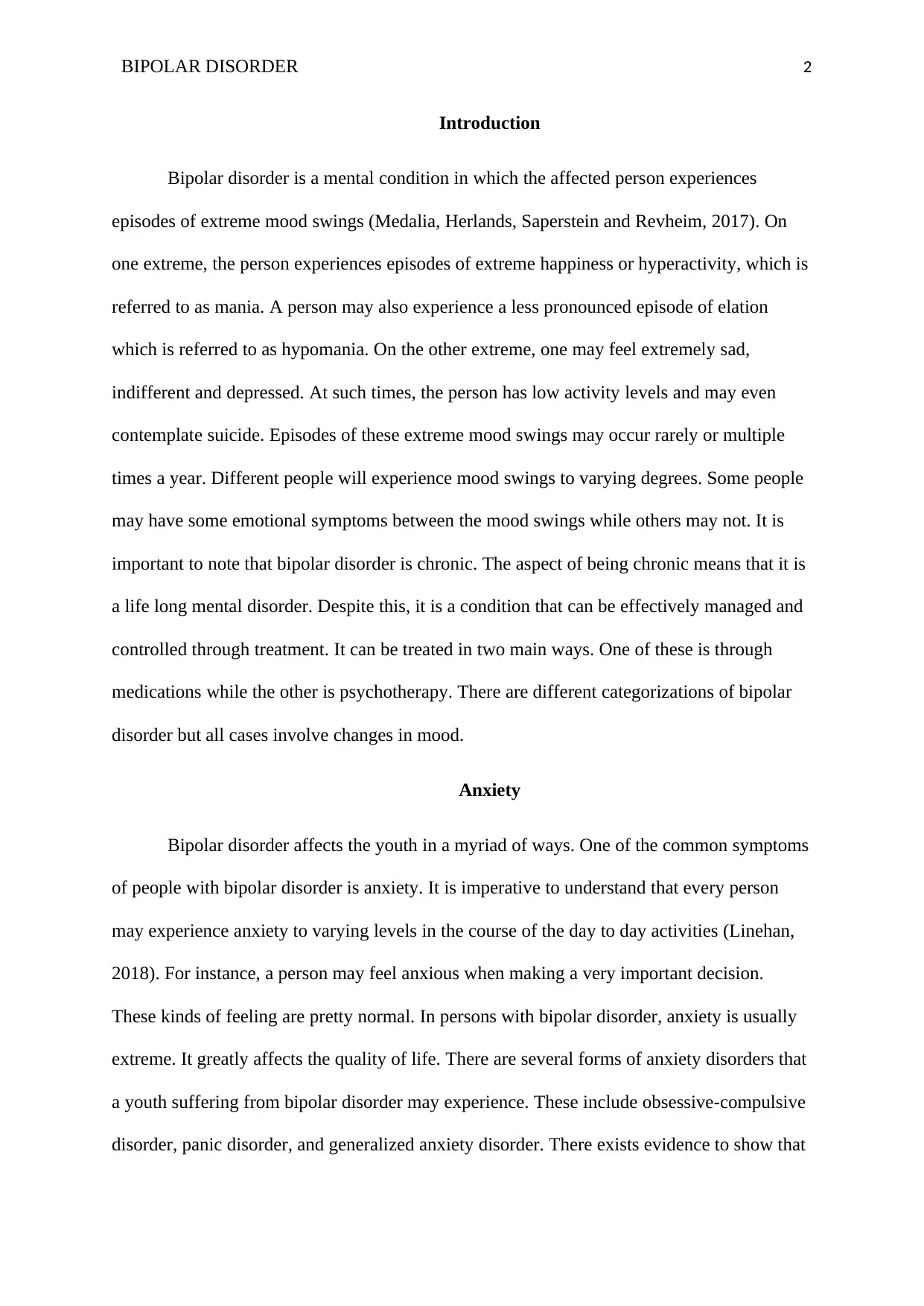
BIPOLAR DISORDER 2
Introduction
Bipolar disorder is a mental condition in which the affected person experiences
episodes of extreme mood swings (Medalia, Herlands, Saperstein and Revheim, 2017). On
one extreme, the person experiences episodes of extreme happiness or hyperactivity, which is
referred to as mania. A person may also experience a less pronounced episode of elation
which is referred to as hypomania. On the other extreme, one may feel extremely sad,
indifferent and depressed. At such times, the person has low activity levels and may even
contemplate suicide. Episodes of these extreme mood swings may occur rarely or multiple
times a year. Different people will experience mood swings to varying degrees. Some people
may have some emotional symptoms between the mood swings while others may not. It is
important to note that bipolar disorder is chronic. The aspect of being chronic means that it is
a life long mental disorder. Despite this, it is a condition that can be effectively managed and
controlled through treatment. It can be treated in two main ways. One of these is through
medications while the other is psychotherapy. There are different categorizations of bipolar
disorder but all cases involve changes in mood.
Anxiety
Bipolar disorder affects the youth in a myriad of ways. One of the common symptoms
of people with bipolar disorder is anxiety. It is imperative to understand that every person
may experience anxiety to varying levels in the course of the day to day activities (Linehan,
2018). For instance, a person may feel anxious when making a very important decision.
These kinds of feeling are pretty normal. In persons with bipolar disorder, anxiety is usually
extreme. It greatly affects the quality of life. There are several forms of anxiety disorders that
a youth suffering from bipolar disorder may experience. These include obsessive-compulsive
disorder, panic disorder, and generalized anxiety disorder. There exists evidence to show that
Introduction
Bipolar disorder is a mental condition in which the affected person experiences
episodes of extreme mood swings (Medalia, Herlands, Saperstein and Revheim, 2017). On
one extreme, the person experiences episodes of extreme happiness or hyperactivity, which is
referred to as mania. A person may also experience a less pronounced episode of elation
which is referred to as hypomania. On the other extreme, one may feel extremely sad,
indifferent and depressed. At such times, the person has low activity levels and may even
contemplate suicide. Episodes of these extreme mood swings may occur rarely or multiple
times a year. Different people will experience mood swings to varying degrees. Some people
may have some emotional symptoms between the mood swings while others may not. It is
important to note that bipolar disorder is chronic. The aspect of being chronic means that it is
a life long mental disorder. Despite this, it is a condition that can be effectively managed and
controlled through treatment. It can be treated in two main ways. One of these is through
medications while the other is psychotherapy. There are different categorizations of bipolar
disorder but all cases involve changes in mood.
Anxiety
Bipolar disorder affects the youth in a myriad of ways. One of the common symptoms
of people with bipolar disorder is anxiety. It is imperative to understand that every person
may experience anxiety to varying levels in the course of the day to day activities (Linehan,
2018). For instance, a person may feel anxious when making a very important decision.
These kinds of feeling are pretty normal. In persons with bipolar disorder, anxiety is usually
extreme. It greatly affects the quality of life. There are several forms of anxiety disorders that
a youth suffering from bipolar disorder may experience. These include obsessive-compulsive
disorder, panic disorder, and generalized anxiety disorder. There exists evidence to show that
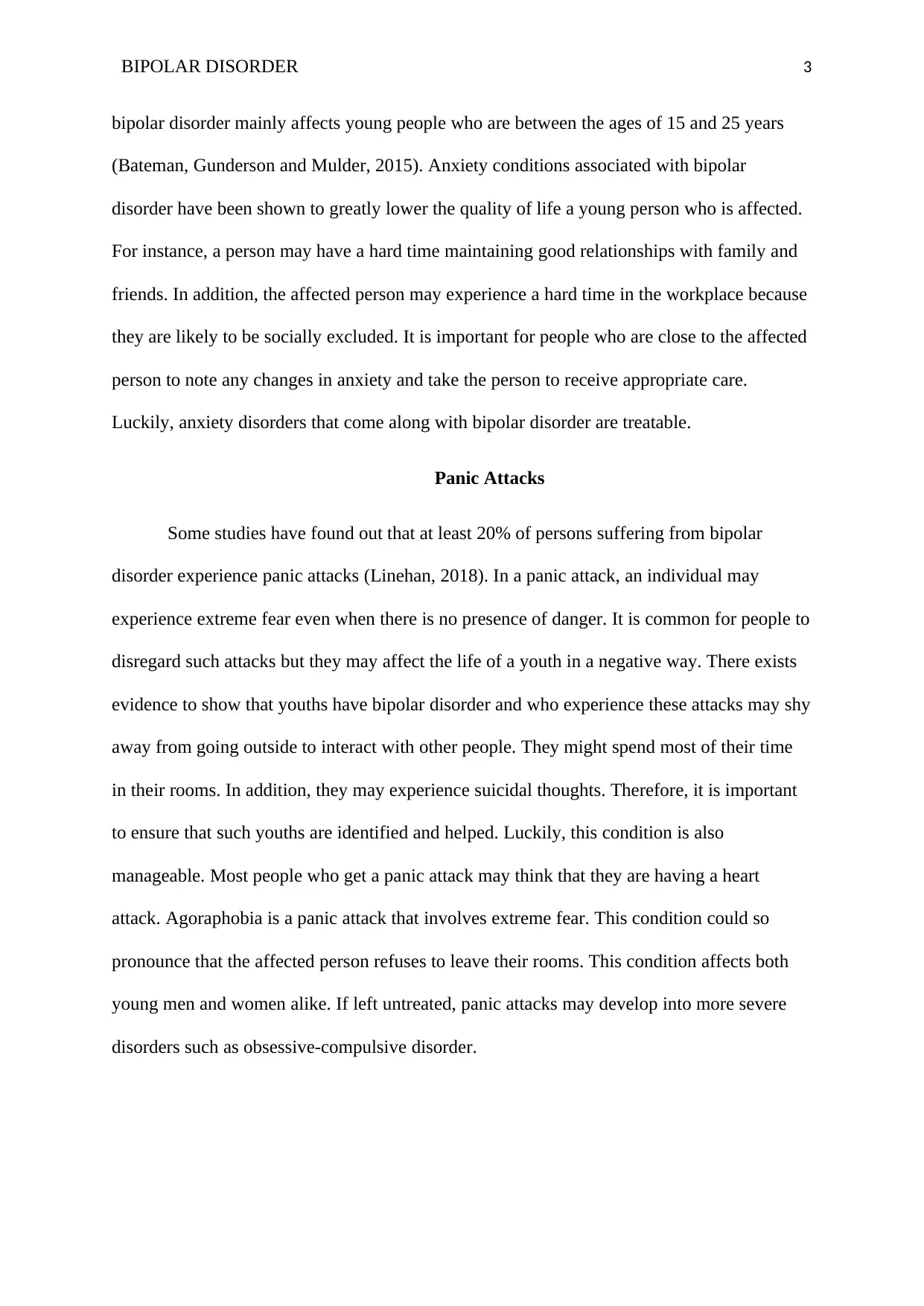
BIPOLAR DISORDER 3
bipolar disorder mainly affects young people who are between the ages of 15 and 25 years
(Bateman, Gunderson and Mulder, 2015). Anxiety conditions associated with bipolar
disorder have been shown to greatly lower the quality of life a young person who is affected.
For instance, a person may have a hard time maintaining good relationships with family and
friends. In addition, the affected person may experience a hard time in the workplace because
they are likely to be socially excluded. It is important for people who are close to the affected
person to note any changes in anxiety and take the person to receive appropriate care.
Luckily, anxiety disorders that come along with bipolar disorder are treatable.
Panic Attacks
Some studies have found out that at least 20% of persons suffering from bipolar
disorder experience panic attacks (Linehan, 2018). In a panic attack, an individual may
experience extreme fear even when there is no presence of danger. It is common for people to
disregard such attacks but they may affect the life of a youth in a negative way. There exists
evidence to show that youths have bipolar disorder and who experience these attacks may shy
away from going outside to interact with other people. They might spend most of their time
in their rooms. In addition, they may experience suicidal thoughts. Therefore, it is important
to ensure that such youths are identified and helped. Luckily, this condition is also
manageable. Most people who get a panic attack may think that they are having a heart
attack. Agoraphobia is a panic attack that involves extreme fear. This condition could so
pronounce that the affected person refuses to leave their rooms. This condition affects both
young men and women alike. If left untreated, panic attacks may develop into more severe
disorders such as obsessive-compulsive disorder.
bipolar disorder mainly affects young people who are between the ages of 15 and 25 years
(Bateman, Gunderson and Mulder, 2015). Anxiety conditions associated with bipolar
disorder have been shown to greatly lower the quality of life a young person who is affected.
For instance, a person may have a hard time maintaining good relationships with family and
friends. In addition, the affected person may experience a hard time in the workplace because
they are likely to be socially excluded. It is important for people who are close to the affected
person to note any changes in anxiety and take the person to receive appropriate care.
Luckily, anxiety disorders that come along with bipolar disorder are treatable.
Panic Attacks
Some studies have found out that at least 20% of persons suffering from bipolar
disorder experience panic attacks (Linehan, 2018). In a panic attack, an individual may
experience extreme fear even when there is no presence of danger. It is common for people to
disregard such attacks but they may affect the life of a youth in a negative way. There exists
evidence to show that youths have bipolar disorder and who experience these attacks may shy
away from going outside to interact with other people. They might spend most of their time
in their rooms. In addition, they may experience suicidal thoughts. Therefore, it is important
to ensure that such youths are identified and helped. Luckily, this condition is also
manageable. Most people who get a panic attack may think that they are having a heart
attack. Agoraphobia is a panic attack that involves extreme fear. This condition could so
pronounce that the affected person refuses to leave their rooms. This condition affects both
young men and women alike. If left untreated, panic attacks may develop into more severe
disorders such as obsessive-compulsive disorder.
⊘ This is a preview!⊘
Do you want full access?
Subscribe today to unlock all pages.

Trusted by 1+ million students worldwide
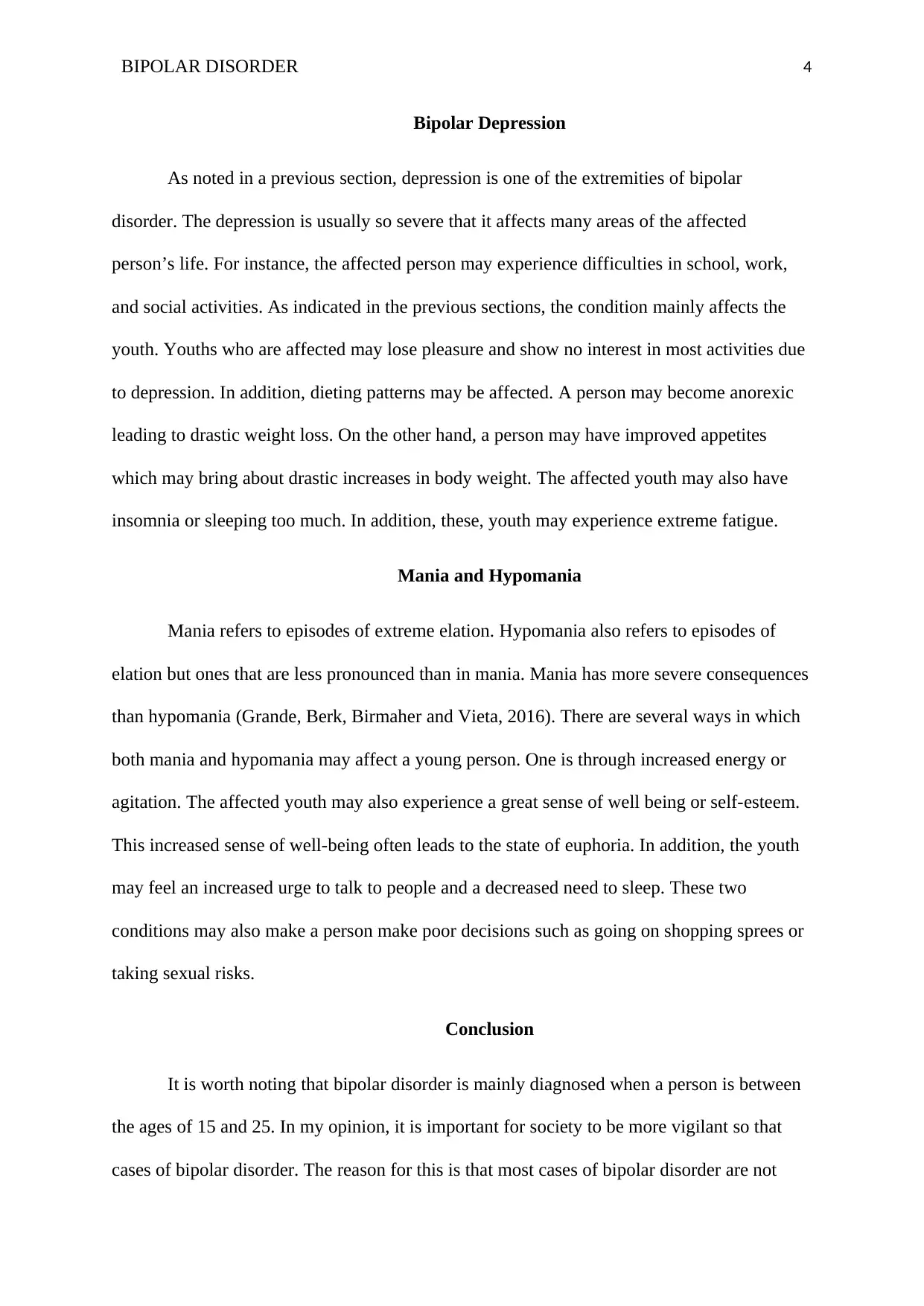
BIPOLAR DISORDER 4
Bipolar Depression
As noted in a previous section, depression is one of the extremities of bipolar
disorder. The depression is usually so severe that it affects many areas of the affected
person’s life. For instance, the affected person may experience difficulties in school, work,
and social activities. As indicated in the previous sections, the condition mainly affects the
youth. Youths who are affected may lose pleasure and show no interest in most activities due
to depression. In addition, dieting patterns may be affected. A person may become anorexic
leading to drastic weight loss. On the other hand, a person may have improved appetites
which may bring about drastic increases in body weight. The affected youth may also have
insomnia or sleeping too much. In addition, these, youth may experience extreme fatigue.
Mania and Hypomania
Mania refers to episodes of extreme elation. Hypomania also refers to episodes of
elation but ones that are less pronounced than in mania. Mania has more severe consequences
than hypomania (Grande, Berk, Birmaher and Vieta, 2016). There are several ways in which
both mania and hypomania may affect a young person. One is through increased energy or
agitation. The affected youth may also experience a great sense of well being or self-esteem.
This increased sense of well-being often leads to the state of euphoria. In addition, the youth
may feel an increased urge to talk to people and a decreased need to sleep. These two
conditions may also make a person make poor decisions such as going on shopping sprees or
taking sexual risks.
Conclusion
It is worth noting that bipolar disorder is mainly diagnosed when a person is between
the ages of 15 and 25. In my opinion, it is important for society to be more vigilant so that
cases of bipolar disorder. The reason for this is that most cases of bipolar disorder are not
Bipolar Depression
As noted in a previous section, depression is one of the extremities of bipolar
disorder. The depression is usually so severe that it affects many areas of the affected
person’s life. For instance, the affected person may experience difficulties in school, work,
and social activities. As indicated in the previous sections, the condition mainly affects the
youth. Youths who are affected may lose pleasure and show no interest in most activities due
to depression. In addition, dieting patterns may be affected. A person may become anorexic
leading to drastic weight loss. On the other hand, a person may have improved appetites
which may bring about drastic increases in body weight. The affected youth may also have
insomnia or sleeping too much. In addition, these, youth may experience extreme fatigue.
Mania and Hypomania
Mania refers to episodes of extreme elation. Hypomania also refers to episodes of
elation but ones that are less pronounced than in mania. Mania has more severe consequences
than hypomania (Grande, Berk, Birmaher and Vieta, 2016). There are several ways in which
both mania and hypomania may affect a young person. One is through increased energy or
agitation. The affected youth may also experience a great sense of well being or self-esteem.
This increased sense of well-being often leads to the state of euphoria. In addition, the youth
may feel an increased urge to talk to people and a decreased need to sleep. These two
conditions may also make a person make poor decisions such as going on shopping sprees or
taking sexual risks.
Conclusion
It is worth noting that bipolar disorder is mainly diagnosed when a person is between
the ages of 15 and 25. In my opinion, it is important for society to be more vigilant so that
cases of bipolar disorder. The reason for this is that most cases of bipolar disorder are not
Paraphrase This Document
Need a fresh take? Get an instant paraphrase of this document with our AI Paraphraser
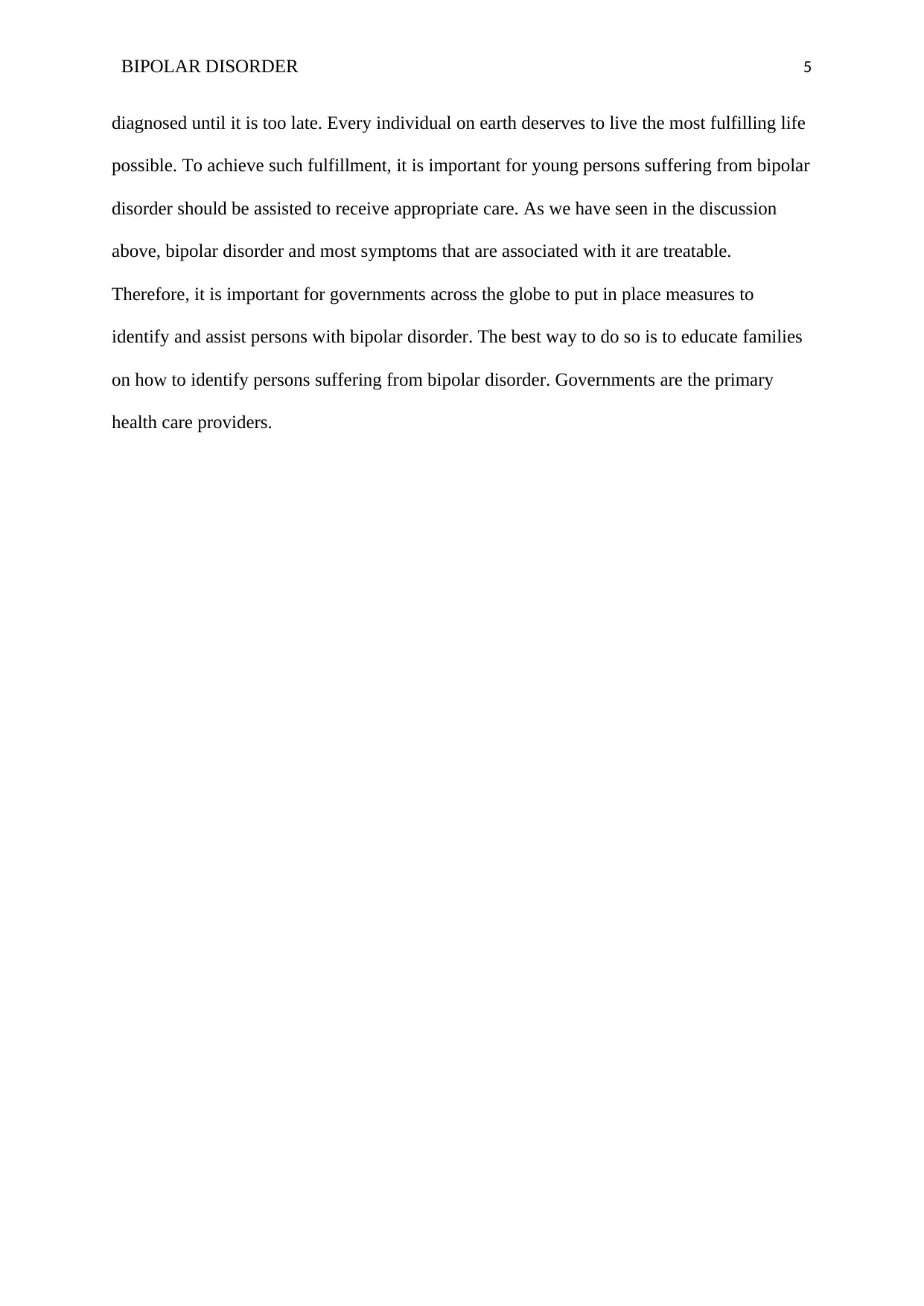
BIPOLAR DISORDER 5
diagnosed until it is too late. Every individual on earth deserves to live the most fulfilling life
possible. To achieve such fulfillment, it is important for young persons suffering from bipolar
disorder should be assisted to receive appropriate care. As we have seen in the discussion
above, bipolar disorder and most symptoms that are associated with it are treatable.
Therefore, it is important for governments across the globe to put in place measures to
identify and assist persons with bipolar disorder. The best way to do so is to educate families
on how to identify persons suffering from bipolar disorder. Governments are the primary
health care providers.
diagnosed until it is too late. Every individual on earth deserves to live the most fulfilling life
possible. To achieve such fulfillment, it is important for young persons suffering from bipolar
disorder should be assisted to receive appropriate care. As we have seen in the discussion
above, bipolar disorder and most symptoms that are associated with it are treatable.
Therefore, it is important for governments across the globe to put in place measures to
identify and assist persons with bipolar disorder. The best way to do so is to educate families
on how to identify persons suffering from bipolar disorder. Governments are the primary
health care providers.
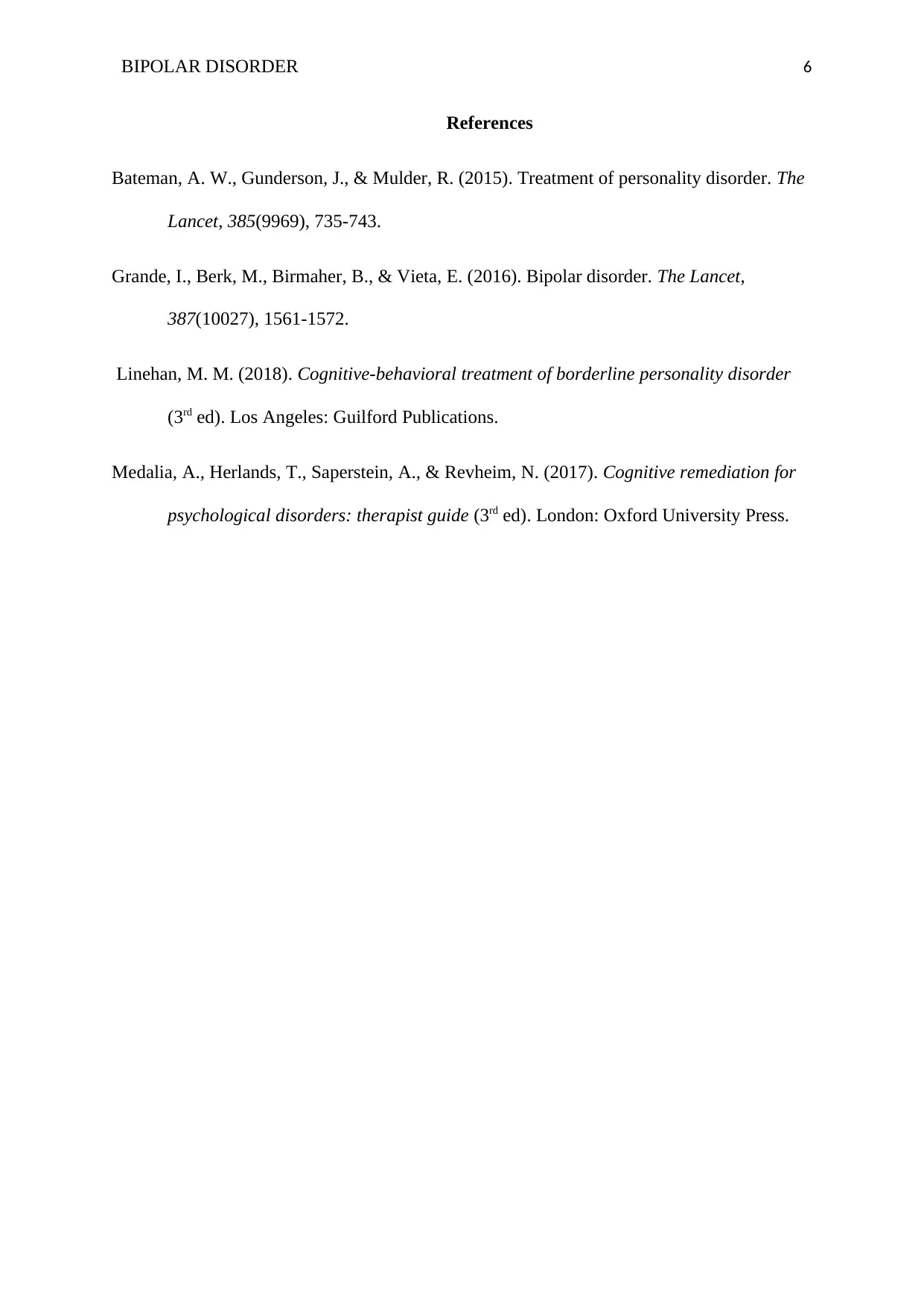
BIPOLAR DISORDER 6
References
Bateman, A. W., Gunderson, J., & Mulder, R. (2015). Treatment of personality disorder. The
Lancet, 385(9969), 735-743.
Grande, I., Berk, M., Birmaher, B., & Vieta, E. (2016). Bipolar disorder. The Lancet,
387(10027), 1561-1572.
Linehan, M. M. (2018). Cognitive-behavioral treatment of borderline personality disorder
(3rd ed). Los Angeles: Guilford Publications.
Medalia, A., Herlands, T., Saperstein, A., & Revheim, N. (2017). Cognitive remediation for
psychological disorders: therapist guide (3rd ed). London: Oxford University Press.
References
Bateman, A. W., Gunderson, J., & Mulder, R. (2015). Treatment of personality disorder. The
Lancet, 385(9969), 735-743.
Grande, I., Berk, M., Birmaher, B., & Vieta, E. (2016). Bipolar disorder. The Lancet,
387(10027), 1561-1572.
Linehan, M. M. (2018). Cognitive-behavioral treatment of borderline personality disorder
(3rd ed). Los Angeles: Guilford Publications.
Medalia, A., Herlands, T., Saperstein, A., & Revheim, N. (2017). Cognitive remediation for
psychological disorders: therapist guide (3rd ed). London: Oxford University Press.
⊘ This is a preview!⊘
Do you want full access?
Subscribe today to unlock all pages.

Trusted by 1+ million students worldwide
1 out of 6
Related Documents
Your All-in-One AI-Powered Toolkit for Academic Success.
+13062052269
info@desklib.com
Available 24*7 on WhatsApp / Email
![[object Object]](/_next/static/media/star-bottom.7253800d.svg)
Unlock your academic potential
Copyright © 2020–2025 A2Z Services. All Rights Reserved. Developed and managed by ZUCOL.





